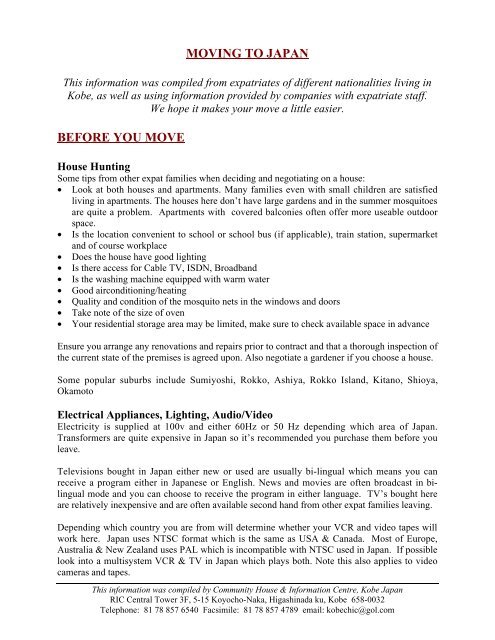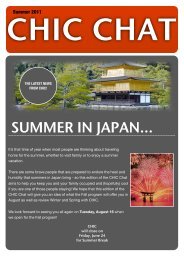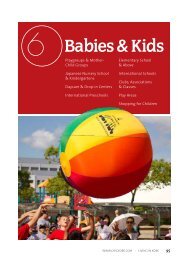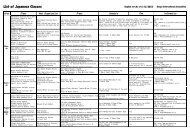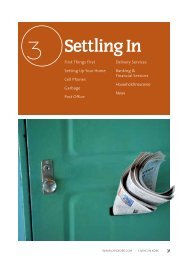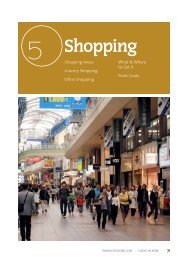MOVING TO JAPAN BEFORE YOU MOVE - CHIC
MOVING TO JAPAN BEFORE YOU MOVE - CHIC
MOVING TO JAPAN BEFORE YOU MOVE - CHIC
Create successful ePaper yourself
Turn your PDF publications into a flip-book with our unique Google optimized e-Paper software.
<strong>MOVING</strong> <strong>TO</strong> <strong>JAPAN</strong><br />
This information was compiled from expatriates of different nationalities living in<br />
Kobe, as well as using information provided by companies with expatriate staff.<br />
We hope it makes your move a little easier.<br />
<strong>BEFORE</strong> <strong>YOU</strong> <strong>MOVE</strong><br />
House Hunting<br />
Some tips from other expat families when deciding and negotiating on a house:<br />
• Look at both houses and apartments. Many families even with small children are satisfied<br />
living in apartments. The houses here don’t have large gardens and in the summer mosquitoes<br />
are quite a problem. Apartments with covered balconies often offer more useable outdoor<br />
space.<br />
• Is the location convenient to school or school bus (if applicable), train station, supermarket<br />
and of course workplace<br />
• Does the house have good lighting<br />
• Is there access for Cable TV, ISDN, Broadband<br />
• Is the washing machine equipped with warm water<br />
• Good airconditioning/heating<br />
• Quality and condition of the mosquito nets in the windows and doors<br />
• Take note of the size of oven<br />
• Your residential storage area may be limited, make sure to check available space in advance<br />
Ensure you arrange any renovations and repairs prior to contract and that a thorough inspection of<br />
the current state of the premises is agreed upon. Also negotiate a gardener if you choose a house.<br />
Some popular suburbs include Sumiyoshi, Rokko, Ashiya, Rokko Island, Kitano, Shioya,<br />
Okamoto<br />
Electrical Appliances, Lighting, Audio/Video<br />
Electricity is supplied at 100v and either 60Hz or 50 Hz depending which area of Japan.<br />
Transformers are quite expensive in Japan so it’s recommended you purchase them before you<br />
leave.<br />
Televisions bought in Japan either new or used are usually bi-lingual which means you can<br />
receive a program either in Japanese or English. News and movies are often broadcast in bilingual<br />
mode and you can choose to receive the program in either language. TV’s bought here<br />
are relatively inexpensive and are often available second hand from other expat families leaving.<br />
Depending which country you are from will determine whether your VCR and video tapes will<br />
work here. Japan uses NTSC format which is the same as USA & Canada. Most of Europe,<br />
Australia & New Zealand uses PAL which is incompatible with NTSC used in Japan. If possible<br />
look into a multisystem VCR & TV in Japan which plays both. Note this also applies to video<br />
cameras and tapes.<br />
This information was compiled by Community House & Information Centre, Kobe Japan<br />
RIC Central Tower 3F, 5-15 Koyocho-Naka, Higashinada ku, Kobe 658-0032<br />
Telephone: 81 78 857 6540 Facsimile: 81 78 857 4789 email: kobechic@gol.com
Other appliances such as food processors, bread baking machines and sewing machines etc<br />
should be brought with you as the products available here are quite small and expensive.<br />
Financial<br />
Be sure to bring financial records with you, including the details of your home sale (if<br />
applicable). Also include at least three years prior tax returns with supporting data. Check with<br />
your tax services department for specific tax returns to bring. Consider consolidating your<br />
checking and savings accounts into one bank. Make sure to set up Internet Banking Access<br />
and/or get a PIN code on a credit card so you can obtain cash in money machines. Japan is a cash<br />
economy; many places do not accept credit cards.<br />
Be sure to bring enough cash with you until you work out your banking arrangements here.<br />
Furniture<br />
Furniture is quite expensive in Japan, especially for Western sized and style furniture. If you need<br />
to replace any of your existing furniture in the coming years it’s a good idea to think about it<br />
before you leave and then it can be included in your shipment. Outdoor furniture/umbrellas can<br />
be found but are not widely available, particularly in larger sizes.<br />
Magazine Subscriptions<br />
You can have your subscriptions changed to your new address in Japan. Usually there is an extra<br />
charge for overseas mailings. The magazines usually arrive 4-6 weeks late. Foreign magazines<br />
purchased in Japan are very expensive.<br />
Medical Work<br />
If you have any medical or dental work that needs attention, get it done before you leave. If you<br />
wear glasses, bring your optical prescription and an extra pair of glasses. Also bring a current<br />
dental chart and your medicals records. If you are taking medicine now, bring a few months<br />
supply with you on the plane and a copy of the prescription. If the prescription is a daily<br />
necessity, bring a year’s supply. It is recommended to bring a note from your doctor in case<br />
Customs questions the large quantity. Many drugs are available here, but it takes time to find the<br />
ones you use. Some prescription patent medicines are not available in Japan. Over the counter<br />
medications are different here, bring a supply of anything you use throughout the year.<br />
Passport Pictures<br />
Bring 12 copies of each family member’s passport photos with you, not in your air shipment.<br />
You will need several pictures for various documents after you arrive. Children will need photos<br />
for student ID’s.<br />
This information was compiled by Community House & Information Centre, Kobe Japan<br />
RIC Central Tower 3F, 5-15 Koyocho-Naka, Higashinada ku, Kobe 658-0032<br />
Telephone: 81 78 857 6540 Facsimile: 81 78 857 4789 email: kobechic@gol.com
WHAT <strong>TO</strong> BRING<br />
Air Shipment<br />
You will have two shipment of goods, one by air designed to arrive soon after your arrival and<br />
your container of goods which will arrive later. It is always difficult to decide what items you<br />
will need when you first arrive in Japan and are waiting for your container. The following list<br />
was made from comments of families who recently located to Kobe. Hopefully, this will make<br />
the decision of what to pack in your air shipment easier. Don’t hesitate to use all the air shipment<br />
space made available to you. Your moving company should even move these items from any<br />
temporary housing to your permanent housing.<br />
Suggested Items for Air Shipment<br />
*Favorite Pillows<br />
*Sheets, comforter/blankets appropriate for the season you are arriving<br />
*Bath towels<br />
*Kitchen towels<br />
*Computer and accessories<br />
*Alarm clock<br />
*Bikes<br />
*Videos and games, mini-stereo system, CDs, tapes<br />
*Sports equipment for kids<br />
*Books/Magazines<br />
*Clothing and hangers<br />
*Coffee maker, filters<br />
*Toaster<br />
*A short supply kit of dishwashing & cleaning items<br />
*Toiletries<br />
*Frying pan, small sauce pan/lid, casserole/lid<br />
*Baking utensils, cake pan, cookie sheet, resealable plastic containers. Smaller size baking tins<br />
are best as many ovens are smaller<br />
*Measuring cups & spoons, spatula, vegetable peeler, paring knife, etc.<br />
*Pot holders<br />
*Can opener, bottle opener, corkscrew<br />
*Some dishes, mugs, and silverware (temporary apartments only furnish the basics: 1 set per<br />
person)<br />
*Favorite cookbook<br />
*Spices<br />
*Some of your favorite convenience foods<br />
*School related items you may need<br />
*Children’s favorite toys/books<br />
*Children’s snack foods<br />
*Camera and scrapbook to begin recording your adventure!<br />
This information was compiled by Community House & Information Centre, Kobe Japan<br />
RIC Central Tower 3F, 5-15 Koyocho-Naka, Higashinada ku, Kobe 658-0032<br />
Telephone: 81 78 857 6540 Facsimile: 81 78 857 4789 email: kobechic@gol.com
Clothing & Shoes<br />
You will find that the Japanese adults dress more formally. They will dress nicely even to run<br />
errands such as shopping. It is o.k. for you to dress more casually, but it is recommended that<br />
you always dress neatly.<br />
You will have the opportunity to attend many functions in Kobe such as private or company<br />
sponsored dinner parties, formal events etc. that require dressy attire. For those events you will<br />
need a few smarter dresses or pantsuits. Men may have the opportunity to attend events where a<br />
tuxedo or formal black suit is worn. Do not expect to find western sizes/proportions in clothing<br />
here.<br />
The average Japanese person is smaller than most Westerners and so it is very difficult to find<br />
clothes, shoes and even furniture here.<br />
Some people have been able to buy clothes for their children here, others have found that the ‘fit’<br />
is not quite right and childrens clothing can be quite expensive. Women’s clothing (if you are<br />
small enough to wear Japanese sizes) is quite expensive. Tall men will find it difficult to<br />
purchase clothes here. The best idea is to bring a year’s supply of clothes for everyone. You can<br />
do mail order but the customs duty and shipping expenses are often very expensive.<br />
You will need a variety of comfortable shoes since you will be walking considerably more than<br />
back home. Japanese in general have smaller feet than westerners so it is best to bring a year’s<br />
worth of shoes with you. Customs duty on footwear is very expensive. Ladies should bring<br />
pantyhose as well.<br />
Underwear and bathing suits are also difficult to find in a wide variety of sizes and can be very<br />
expensive. Also socks for men with large shoe sizes are difficult to find.<br />
Please check with the school you choose to see if your child needs a gym uniform, special shoes,<br />
special supplies etc. Also bring special occasion clothes for children such as a nice dress, suit,<br />
dress shirt and tie etc.<br />
Food & Toiletries<br />
There are many western food items available in the Kobe area. There is a catalog order company<br />
called The Foreign Buyer’s Club, from which you can order items that are not available locally.<br />
They have an extensive catalog of American and British products, and the prices are higher than<br />
in the source country. The FBC shop is located in the Entente Building on Rokko Island, down<br />
the hall from <strong>CHIC</strong>. Other stores in the area specializing in imported goods are Price Club on<br />
Rokko Island, Kobe Grocers in Sannomiya, and Costco in Amagasaki which is a well known<br />
American wholesaler. Camembert is located in Rokko and they have a very good selection of<br />
cheeses and some imported meats and sausages.<br />
Japanese supermarkets generally don’t carry many international products. Ikari & Peacock<br />
supermarkets are a little bit more international though their branches are limited.<br />
Japanese supermarkets are fine for basic produce/meat/dairy etc.<br />
This information was compiled by Community House & Information Centre, Kobe Japan<br />
RIC Central Tower 3F, 5-15 Koyocho-Naka, Higashinada ku, Kobe 658-0032<br />
Telephone: 81 78 857 6540 Facsimile: 81 78 857 4789 email: kobechic@gol.com
There is an American craft store & hardware located on Rokko Island. Ben Franklin (crafts) and<br />
next door is Ace hardware.<br />
This is a list of items people have found difficult to find or very expensive.<br />
You may want to bring these things along with you as they are difficult to find or different from<br />
what you are used to.<br />
Food:<br />
• Food coloring<br />
• Low sodium products<br />
• Low fat products<br />
• Sugar free soft drinks and sugar free powdered drink mixes<br />
• Iodized salt<br />
• Decaffeinated coffee and tea<br />
• Caffeine free soda<br />
• Good selection of baby food (Japanese brands & Gerber are available but difficult to read<br />
labels with contents)<br />
• Items for baking<br />
• Cake decorating materials and pure icing sugar (icing sugar available but not the pure kind)<br />
• Whole-wheat flour<br />
• Uncommon canned vegetables (butterbeans, wax beans etc.)<br />
• Sugar free gum, candy<br />
• Gelatin & pudding mixes<br />
• Powdered milk & buttermilk<br />
• Maple syrup (expensive here)<br />
• Childrens cereal<br />
Toiletries:<br />
Bring one year supply of your favorite brands.<br />
• Shampoos, conditioners (formulated for Japanese hair)<br />
• Toothpaste (Japanese toothpaste usually doesn’t have fluoride)<br />
• Deodorant (ineffective due to differences in pH level, plus summer is very hot!)<br />
• Deodorant body soap<br />
• Tampons and pads (Japanese brands are expensive and inadequate)<br />
• Body lotions (usually in small size packages and there is a limited offering)<br />
• Makeup and skincare products (many Japanese products have ‘Whitening’ formulation)<br />
This information was compiled by Community House & Information Centre, Kobe Japan<br />
RIC Central Tower 3F, 5-15 Koyocho-Naka, Higashinada ku, Kobe 658-0032<br />
Telephone: 81 78 857 6540 Facsimile: 81 78 857 4789 email: kobechic@gol.com
Miscellaneous<br />
This is a list of items people have found difficult to find or very expensive.<br />
You may want to bring these things along with you as they are difficult to find or different from<br />
what you are used to.<br />
• Sheets, pillowcases, pillows and bedspreads to fit your bed (Japanese sizing is different)<br />
• Towels and bath rugs (Japanese towels are smaller and thinner)<br />
• Bicycle parts, tire pumps, needles<br />
• Replacement parts for appliances, office supplies, etc.<br />
• Smoke detectors<br />
• Humidifier tablets and filters<br />
• Some contact lens solutions<br />
• Three-way light bulbs<br />
• Software, especially for children<br />
• Children’s lunch boxes, brown paper lunch bags<br />
• Vacuums, vacuum bags (Japanese vacuums do not have strong suction)<br />
• Measuring spoons/cups (Japanese are metric)<br />
• Clothing & Shoes see section under Weather/clothing/shoes<br />
• Transformers<br />
• Outdoor/garden furniture<br />
• Books, magazines and videos in your own language<br />
• Lamps and shades<br />
• Sports equipment<br />
• Underwear<br />
• Gas BBQ grill – the moving company should ship the BBQ without the gas cylinder.<br />
Cylinders can be purchased here.<br />
• Artificial Christmas tree<br />
• Christmas music, decorations<br />
• Decorations for any holiday you wish to celebrate<br />
• Extension cords<br />
• Small fans<br />
• Gifts for children for 1 st Christmas in Japan<br />
• Desk and floor lamps, in general lighting is not very good<br />
• Tools for household/auto maintenance<br />
Medical & Pharmacy<br />
There are some English speaking doctors and dentists in the Kobe area. In general dental offices<br />
do not have Western style hygenists or preventative care. Make sure to take care of this before<br />
you leave. Plan to bring a year’s supply of the medicines your family needs, including over the<br />
counter medications. You should also bring a years supply of contraceptives if necessary as the<br />
products available here may not be suitable. Make sure to purchase the “Medical Access – A<br />
Foreigner’s Guide to Health Care in Kobe” if your company does not provide you with one. It is<br />
an excellent referral source to doctors, their specialties, hospital information etc.<br />
This information was compiled by Community House & Information Centre, Kobe Japan<br />
RIC Central Tower 3F, 5-15 Koyocho-Naka, Higashinada ku, Kobe 658-0032<br />
Telephone: 81 78 857 6540 Facsimile: 81 78 857 4789 email: kobechic@gol.com
You should also bring a years supply of regular over the counter medications such as painkillers,<br />
cough/cold medicines, antiseptic creams and general first aid type products. You should also<br />
bring any vitamins you regularly take.<br />
• Fluoride or fluoride vitamins if advised by your dentist. There is no fluoride in the water.<br />
• Diaper rash ointments and creams<br />
• Mosquito repellent<br />
• Infant & Childrens painkiller (eg Paracetamol, Tylenol). Only available by prescription here<br />
and only for 3-4 days at a time.<br />
• Hydrocortizone cream & other pharmaceutical creams<br />
• Acne treatments<br />
• Contraceptives<br />
• Calamine lotion<br />
• Home hair colouring<br />
Pets<br />
If you have a pet, you may want to bring extra collars, leashes and flea collars. Choker collars<br />
and collars for big dogs can not be purchased here. Special diet food may not be available.<br />
Heartworm medicine is very expensive here. Cat litter is available, but not very good. Pet food<br />
is available in small packages.<br />
You might also want to get all their checkups and immunizations done prior to moving. (This is<br />
aside from Japanese quarantine regulations for your country)<br />
LOCAL AREA INFORMATION<br />
Religious venues – Kobe Area<br />
There are English language services at two Protestant and several Catholic churches. However,<br />
there is no Christian radio or television. So if you enjoy listening to religious music, you should<br />
bring your favorites. There are additional details on other faiths in your “Living in Kobe” book.<br />
In Kitano, there is a Jewish Center and a Mosque. There are also 3 Indian Temples located in the<br />
Sannomiya/Kitano.<br />
There are classes available at some churches for the children to continue their religious education<br />
or bring your own material.<br />
Protestant Churches: Kobe Union Church and Kobe International Baptist Church<br />
Catholic Churches: Marist Brothers (near Shioya), Rokko Catholic Church (East side of Kobe),<br />
Nakayamate Sacred Heart Church (Kobe).<br />
This information was compiled by Community House & Information Centre, Kobe Japan<br />
RIC Central Tower 3F, 5-15 Koyocho-Naka, Higashinada ku, Kobe 658-0032<br />
Telephone: 81 78 857 6540 Facsimile: 81 78 857 4789 email: kobechic@gol.com
International Schools<br />
There are five private international schools in the area from which to choose. Your relocation<br />
advisors should be able to set up appointments for you to visit the schools during your house<br />
hunting trip. Pick up any registration materials at that time. If possible, bring academic records<br />
with you.<br />
Canadian Academy on Rokko Island has an extensive web site. www.canacad.ac.jp<br />
Marist Brothers located in Suma, west of Kobe. Christian-Marist approach to education. Web<br />
site: www.marist.ac.jp./<br />
St. Michael’s International School sponsored by the Anglican Church of Japan offers classes preschool<br />
through grade 6. Instruction is based on the British National Curriculum.<br />
The European School-for elementary school aged children.<br />
Web site: www2.gol.com/users/dsk<br />
Osaka International School , located in Minoh, Osaka<br />
www.sisf.minoh.osaka.jp/<br />
Please be aware that in the Kobe area there is no school that accepts or can provide for<br />
students with special educational needs.<br />
English in Japan<br />
English is taught as a second language in most Japanese schools. After years of study some<br />
Japanese read and write English, however a small percentage can actually speak English with any<br />
proficiency. Foreigners also have a difficult time speaking Japanese with any degree of fluency.<br />
However it is helpful to learn as much Japanese as possible to assist in shopping and traveling.<br />
Transportation in Japan<br />
The public transportation in Japan is excellent and relatively simple to use. You will quickly<br />
learn how to use the trains, buses, taxis and subways as you travel with others or explore on your<br />
own.<br />
You may or may not wish to purchase a car in Japan. There are families that do not own cars.<br />
Cars are useful for getting to out of the way places. Generally, trains and subways can get you<br />
just about anywhere you need to go in the metropolitan area. You can find both new and used<br />
cars in Japan. If you prefer a new car, keep in mind that new cars experience a very steep<br />
depreciation in Japan. Depending on the timing of your assignment, you can get a good deal on a<br />
used car from another expatriate leaving Japan. In either case, you will need help in completing<br />
all the necessary paperwork involved in purchasing a car. You can drive on an international<br />
drivers license for 1 year after which you will need to get a Japanese drivers license. Several<br />
countries have reciprocity regarding drivers’ licenses and no test is necessary. You will need to<br />
determine your<br />
particular status.<br />
This information was compiled by Community House & Information Centre, Kobe Japan<br />
RIC Central Tower 3F, 5-15 Koyocho-Naka, Higashinada ku, Kobe 658-0032<br />
Telephone: 81 78 857 6540 Facsimile: 81 78 857 4789 email: kobechic@gol.com
Weather<br />
In Kobe it rarely gets colder than 32 0 F / 0 0 C. The best option for winter is layering your clothes.<br />
It seldom snows in the Kobe area, but do bring a winter coat, gloves, and hat. Most homes do not<br />
have central heating and heat with air conditioners/gas heaters. The heating in many public<br />
places and in trains is set quite high therefore clothes should not be too thick.<br />
Spring and Fall are extremely pleasant. The temperatures are warm and the sun shines most of<br />
the time. Usually a lightweight jacket is sufficient.<br />
Summer is very hot, very humid and very rainy. You will need several umbrellas; folding ones<br />
are especially convenient. Average temperature around 95 0 F / 35 0 C and 90% humidity.<br />
Kansai/Japan has many great hiking trails. Bring hiking shoes/socks/clothes with you if you’re<br />
interested in exploring the mountains in Kansai.<br />
Arriving at Kansai International Airport<br />
Arriving at the airport in Japan for the first time can be a bit overwhelming. This information is<br />
designed to give you a preview of what to expect and how you might react to certain events.<br />
Arrange with your company in advance to be picked up and taken to your temporary residence or<br />
get specific instructions from them on how to get there yourself.<br />
-When you arrive at KIX, disembark along with everyone else. The airport is easy to navigate<br />
with signs in English. Your first stop will be immigration. You will ride an automated train to<br />
the main terminal building.<br />
-Once you leave the train, go down the escalator into the immigration area.<br />
-Once inside the immigration room, you will see the immigration officers to your right.<br />
-Over each booth will be a sign that says Foreign Passports or Japanese Passports. Go to the<br />
foreign passport line. Usually you can step up to the window as a family.<br />
-Once you are through immigration, follow the signs to the baggage claim area. Baggage carts<br />
are free. Locate the baggage carousel for your flight and claim your baggage.<br />
-Now head to Customs. The customs officials generally speak a few words of English. You may<br />
be asked what company you work for.<br />
-After you clear customs, go through the double doors and you will be in a waiting/pick up area.<br />
Outside that area is where you find taxis and buses.<br />
Miscellaneous<br />
Disasters<br />
In Japan, you may experience earthquake tremors and seasonal typhoons, it is important that you<br />
recognize there are specific safety measures to take in the event of an emergency. Your<br />
relocation personnel should be able to advise you. Your employer may also have a company<br />
disaster plan.<br />
Consulate<br />
Make sure to register yourself and your family at your home country’s Embassy or Consulate<br />
office.<br />
This information was compiled by Community House & Information Centre, Kobe Japan<br />
RIC Central Tower 3F, 5-15 Koyocho-Naka, Higashinada ku, Kobe 658-0032<br />
Telephone: 81 78 857 6540 Facsimile: 81 78 857 4789 email: kobechic@gol.com
This information was compiled by Community House & Information Centre, Kobe Japan<br />
RIC Central Tower 3F, 5-15 Koyocho-Naka, Higashinada ku, Kobe 658-0032<br />
Telephone: 81 78 857 6540 Facsimile: 81 78 857 4789 email: kobechic@gol.com


